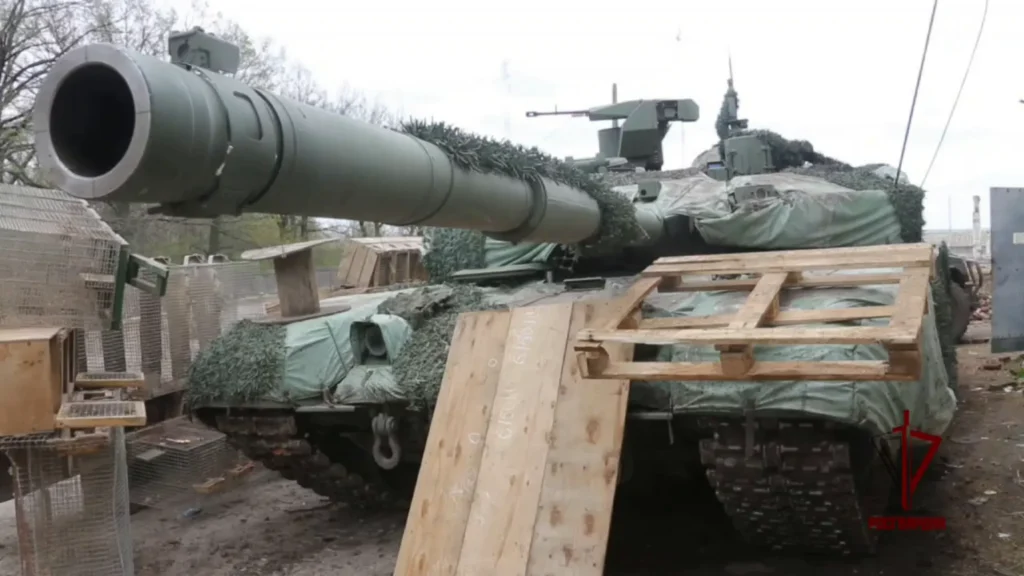The Kalashnikov Conglomerate announced in a press release dated June 26 that its group company, “NII Stali,” has begun supplying engineering companies with “Nakidka” (also known as Stealth Technology System (STS)) camouflage material produced domestically.
JSC ‘NII Stali’ has begun delivering the specialised protective material ‘Nakidka,’ which reduces the visibility of tanks and other combat vehicles across a broad spectrum of wavelengths for use in combat conditions, said the statement, adding that several domestic engineering firms have received initial samples of “Nakidka” from NII Stali to retrofit their tanks with this form of protection.
The corporation said anti-tank weapons, artillery shelling, and long-range missile assaults render armoured vehicles inoperable. After the adversary detects the vehicles via satellite or aerial surveillance, they are bombarded. The Nakidka cape, which is applied to the armoured vehicle like a cover on the phone, prevents radar and thermal imaging reconnaissance devices from detecting vehicles. The disruptive colouration of the material also provides optical camouflage. It is noted that “Nakidka” is now a piece of required equipment for Russian armoured vehicles deployed to the combat zone.
During a special military operation in August 2022, a T-90M “Proryv-3” tank equipped with camouflage reduction measures, including “Nakidka,” was spotted in the operational area. In addition, a lattice structure was added to the turret’s roof.

Nakidka Cape camoflage
Scientific Research Institute of Steel, also known as NII Stali, was responsible for the Nakidka cape development, and once it was finished in the 1990s, it was displayed at various exhibitions. Camouflage kits and other examples of the new, one-of-a-kind material were displayed on Russian military vehicles and exhibits of the new material.
During these events, the “Nakidka’s” intrinsic capability to outfit tanks of all significant Russian self-propelled artillery units, armoured personnel carriers, infantry fighting vehicles, and other military hardware was fully displayed. On the other hand, the Russian military did not show much enthusiasm for the STS and took its sweet time implementing the system’s capabilities.
After completing all the necessary paperwork, the development team immediately began promoting “Nakidka” internationally. There were whispers of interest from nearby and faraway countries, but export success remained modest. The first reported order for the new systems came from Armenia in 2005; since then, further equivalent contracts have yet to be reported.
The covers are composed of radio-absorbing material (RAM) known as “Nakidka,” also the name of the entire complex. It is an 8-10 mm thick, multilayered structure with special synthetic thermal insulation materials. The RAM’s internal layers capture radiation within specific spectral ranges, while the RAM’s outer layer protects across the board. In addition, it can be painted with special enamels and accessorised with various camouflage elements. The material helps the vehicle’s outer surface temperature correspond to the surrounding air’s temperature.
“Nakidka” reduces the maximum distance the American airborne radar Boeing E-8 Joint STARS can differentiate between wheeled and tracked vehicles based on secondary Doppler characteristics from 180 kilometres to 30 to 40 kilometres.
The “Nakidka” upgrade provides the tank with the front, rear skirt and side screens. Because of the cape, the effective range of several types of anti-tank guided missiles (ATGMs), which use radar and thermal guidance systems, has decreased.
The US Javelin top attack anti-tank guided missile (ATGM) was the first system to be affected by the introduction of thermal camouflage. The thermal signature of the “Nakidka” clad tank, used by the Javelin’s onboard computer to monitor and target, has been reduced by six or more, according to the findings of foreign analysts studying the tank’s characteristics. Simply put, a tank with such camouflage is challenging to detect and target with infrared vision; where there is no target acquisition, no shots are fired.
The “Nakidka” can be mounted on Russian armoured vehicles, such as the T-72B, T-72B3, and T-80. The system has been effectively implemented on the T-90M “Proryv” developed in Russia over several years. When it comes to tanks, the STS provides nearly complete coverage of both the hull and the turret, yet it does not impede the use of the weaponry.
The “Proryv” is essentially a simplified variant of the T-14 “Armata.” All instruments, fire control systems, and life support systems from the fourth-generation tank have been transferred to the T-90M. The “Proryv’s” firing range of five kilometres is adequate to engage the enemy Western from a safe distance, change position, and continue combat operations.
The dense fabric of the “Nakidka” is made from a special material that completely neutralises four missile guidance channels: thermal emissions, radio-thermal beams, radar reflection, and infrared target perception are reduced by several times. As a result, not only nighttime shooting at the tank is hindered, but also daytime targeting.
